Everest
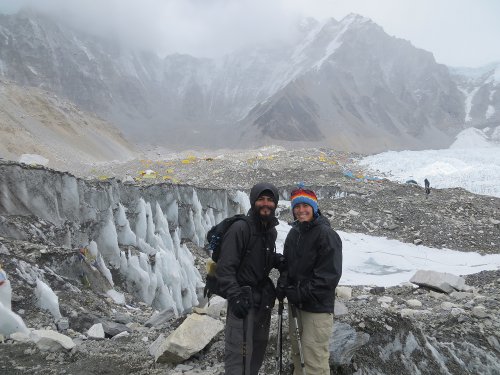

From April 24 to May 6, 2013, we independently explored Sagarmatha National Park in Nepal by foot. The 13-day trek gave us a great taste of the Himalayas, their Sherpa community, and unforgettable views of Mt Everest from the peak of Kala Patthar at 5,550 meters (18,209 ft) of elevation and Everest Base Camp at 5,364 meters (17,598 ft). During the first 9 days, we hiked up starting in Lukla at 2,840 meters (9,317 ft) and making overnight stops for acclimatization in the lovely towns of Monjo, Namche Bazar, Tengboche, Pangboche, Dingboche, Lobuche, and Gorak Shep. We also completed acclimatization day hikes to the towns of Thamo from Namche Bazar and Chhukhung from Dingboche. On the last 4 days, we made our way down from Kala Patthar to Lukla, making overnight stops in the towns of Periche, Phungi Thanga, and Phakding. We hiked an average of 6 hours per day, traveled a total distance of 144 km (89 ft), and climbed up a total of 2,710 meters (8,891 ft) while carrying backpacks of 15 and 11 kilos (33 and 24 lbs) across the Khumbu region.

Our journey began in Kathmandu where the process of buying a flight to Lukla was by itself an adventure. We spent hours walking and talking with different tourist agents trying to find tickets that would match our itinerary. After two tiring days of searching around the chaotic and colorful streets of Nepal’s capital, we were finally ready to take off. Little we knew, our departure will take longer than we expected due to cancelled flights to Lukla because of bad weather conditions. This was the case for us and many other travelers at the Kathmandu Domestic Airport on April 22, 2013.
We were lucky to reschedule our tickets and flight to Lukla on April 24, 2013 at 6:15 am. This amazing trip that ended on a successful landing over the most dangerous airport on earth, allowed us to see for first time the peak of Mt Everest. Our tears of joy could not describe the magic we felt to be so close to the top of the world!

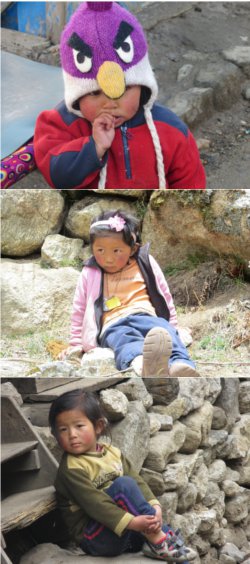
As we started hiking, we began to enjoy the culture of the Sherpa community of the Nepalese Himalayas. On our first day of walking, a little boy of no more than 2 years old ran handing strawberry flowers to welcome us into his land. We walked to the rhythm of music from the locals and bells hanging from the necks of yaks and mules. The yaks and mules are used to carry loads of food and supplies. We felt warm with the kindness of many Sherpas whom regardless of their heavy baskets or fast pace, always made an effort to acknowledge us and say “Namaste” (Hello/Goodbye). The people, blue rivers, swinging bridges, vegetable gardens, praying wheels, and postcard mountain views were the breeze of fresh air we needed to counteract the challenges of high altitude.


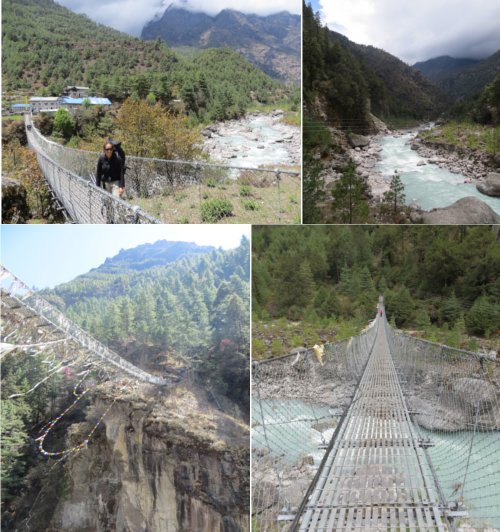
Yaks Passing Us on the Everest Base Camp Trek
The trails to Everest Base Camp are busy roads of local people and travelers. Most of the towns along the way have tea houses that offer food and accommodation, making this hiking experience a very comfortable one. All the products that go up or down these small Himalayan villages are carried by people or animals. We encounter tourists from different countries traveling both independently or as part of an organized tour.
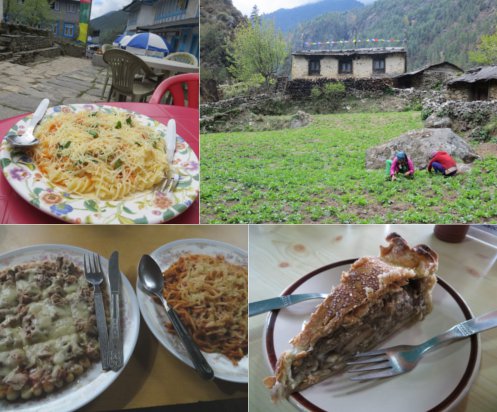
We felt really sad seeing the way in which many of the organized tours take advantage of the local people and disappointed by many travelers promoting this way of modern slavery. Many tourists feel that they cannot carry their own backpacks and pay Sherpas to carry it for them. We understand that getting help to carry your heavy luggage for a strenuous hike of multiple days could be a good idea, but we cannot comprehend why a person that is not capable to lift their own bag will think it is right to give another human being up to three or more bags to carry. In what moment does the few dollars you pay justify this selfish decision? How could you feel excited and proud to reach the highest mountain on earth while causing pain and suffering to another person? Many Sherpas carry from 60 to 70 kg (132 to 154 lbs) without the right equipment to protect their backs, proper nutrition, water, clothing, and even shoes for this type of trail and climate. Why do tourists that come from developed countries, where the fight for fair working conditions have been battled, will go to another nation to take advantage of people’s poverty and promote this type of inhumane treatment? We truly hope the government of Nepal will implement more strict and protective regulations, so Sherpas will stop being exploited and tourist agencies will be forced to decrease the amount of weight porters carry. In reality, if porters are not allowed to carry so much weight, tourist will have to hire more of them, and it could potentially represent more job opportunities.
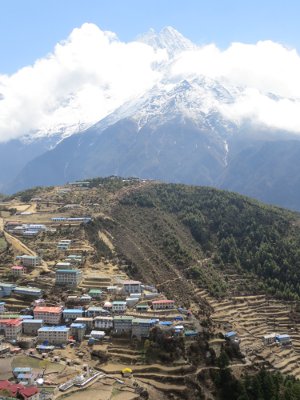
We were able to visit the town of Thamo on a day hike from Namche Bazar to acclimate. This pleasant hike took us to a Tibetan monastery that has been under construction for the last 10 years, because Himalayan weather only allows 3 months of work per year and the funding is mainly coming from donations. During our visit, we had a great conversation with Lobsang, a Tibetan monk supervising the construction, and other nuns living in the old monastery. Lobsang shared with us the sad history of his country, which was invaded by China in 1949 without much international opposition. Regardless of the Tibetan’s request for help to the United Nations and other powerful countries like the USA, the Dalai Lama had to eventually be exiled to India in 1959 and every year Tibetan monks self-emulate themselves as their only form of protest against the Chinese occupation. Although the count has already reached 100 deceased monks, the international concern to free Tibet does not seem to progress. We wonder if Tibet would pose attractive sources of petroleum to exploit, maybe political interest and intervention of “helper” nations would be greater.
The destruction of Tibet’s culture and oppression of its people was brutal during the 20 years following the uprising of China. 1.2 million Tibetans, one-fifth of the country’s population, died as a result of China’s policies. According to an estimate by the Tibetan government in exile, many more languished in prisons and labor camps, and more than 6,000 monasteries, temples, and other cultural and historic buildings were destroyed and their contents pillaged. Many Tibetans like Lobsang have found refuge in India and Nepal. Lobsang left Tibet in the year 2000 and the last time he was able to see his family was in 2003. Since 2008, the Chinese government closed the borders of Tibet, restricting the access to any national and foreigners with desires to visit the land of snows. At this point, any tourist with interests of going to Tibet has to pay very high fees, including the cost of a “tour guide” that accompanies you at all times, making sure tourist have limited contact with locals. We strongly disagree with China’s occupation and oppression of Tibetan culture and decided to renounce our desire to visit it on Our First World Trip. Free Tibet!
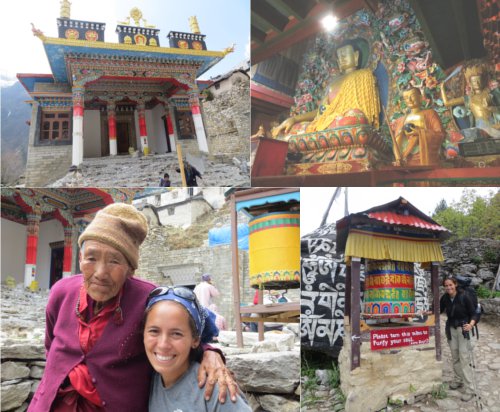

The second and fourth days of trekking were really challenging. Gisela struggled going up steep hills, as walking and breathing became difficult at higher elevation. On the fifth day, Sal felt tired and lightheaded while walking. Although we stopped to rest, Sal’s symptoms of altitude sickness increased from mild to moderate and he experienced nausea and fever. We had to spend the night in Pangboche with the uncertainty of Sal’s health and the future of our journey. Many tourists are rescued in helicopter from the Himalayas due to altitude sickness and we feared it was going to be the end of our adventure. However, the next morning Sal woke up feeling 100% better and we decided to continue the hike. Going slowly and regularly drinking small amounts of water became the best strategy to beat the challenges of high elevation and allow our bodies to adapt to the lower levels of oxygen. This scary incident thought us that the mountains need to be approached with humility and respect, as you are permitted to proceed only when nature permits it.
The landscape started to change dramatically after we passed the 3,800 meters (12,467 ft) of altitude. Spectacular rocky formations without trees, glaciers, and memorials in honor to the many mountaineers that had lost their lives while trying to make it to the Everest summit, became our scenery until reaching Everest Base Camp and Kala Patthar summit. We learned a lot about Edmund Percival Hillary and Tenzing Norgay Sherpa, the first two men who climbed to the peak of Mt Everest on May 29, 1953. As the 60th anniversary of this memorable day gets closer, the tenacity of these men and their group of mountaineers inspired us to keep going. Although the New Zealander, Hillary, came to Everest initially for the mountains, he stayed in Nepal for the people. After reaching the top of the world, he devoted his time to improve the quality of life of children and families in the Khumbu by building many schools and hospitals in the region.
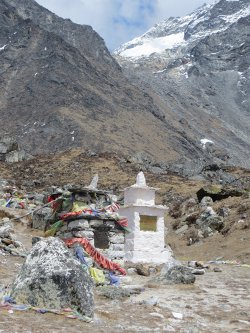
As we got closer to our goal, the Himalayas laid a white carpet of thin snow to receive us. The freezing cold digged through our bones in the early morning, while we hiked up to be rewarded by the most memorable sunrise view of Mt Everest from Kala Patthar. Our eyes became once again, tears of full satisfaction and gratitude for this wonderful life we are living. Similar to any conquests, we achieved these seconds of glory after days of sacrifices, endurance, and perseverance. If someone would ask us why we would go through so many struggles and challenges to see Mt Everest? Without a doubt we would answer like many others: “Because it is there.”

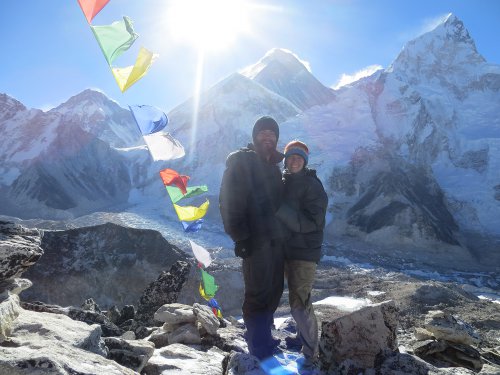
View from Kala Patthar
